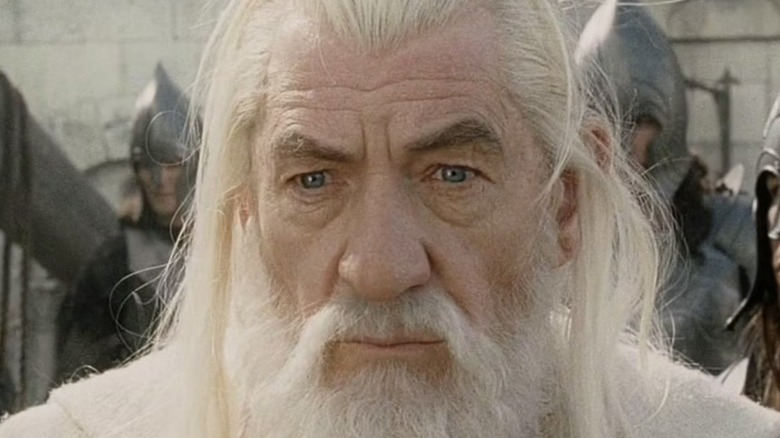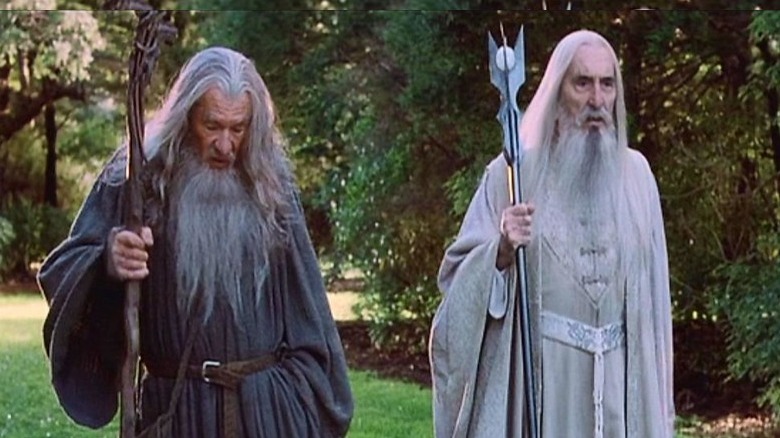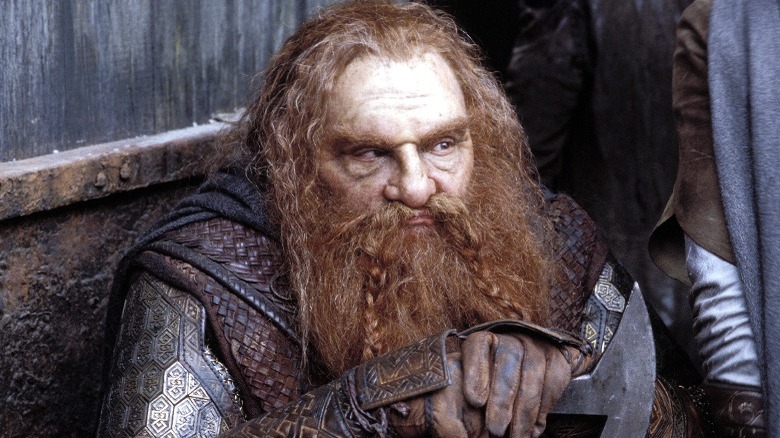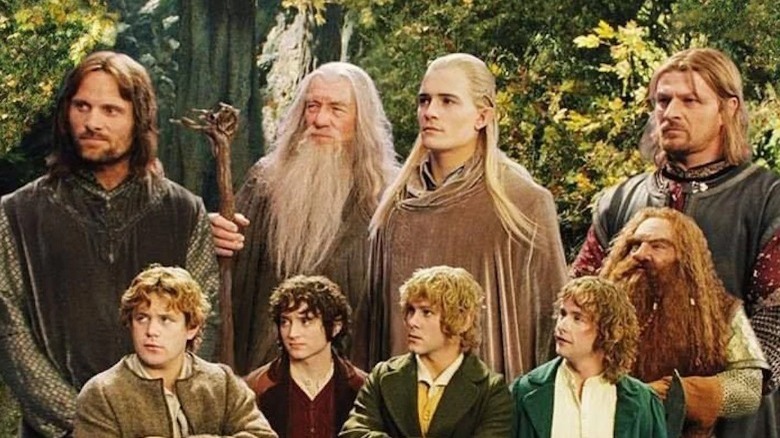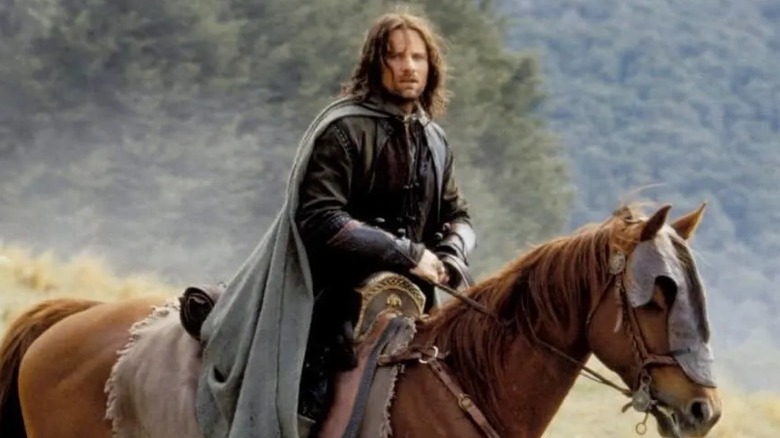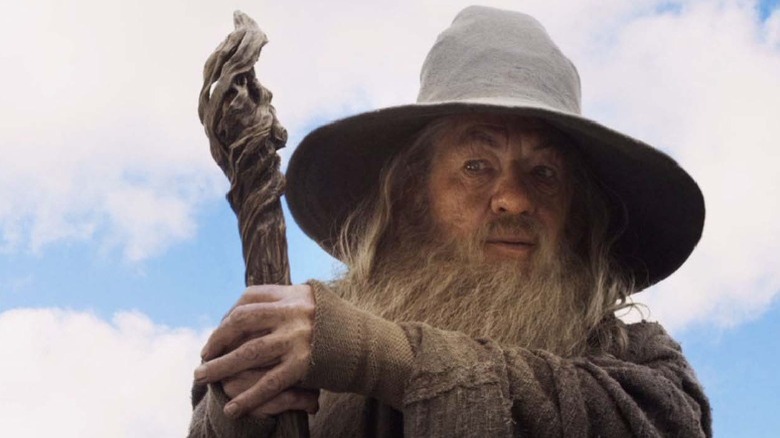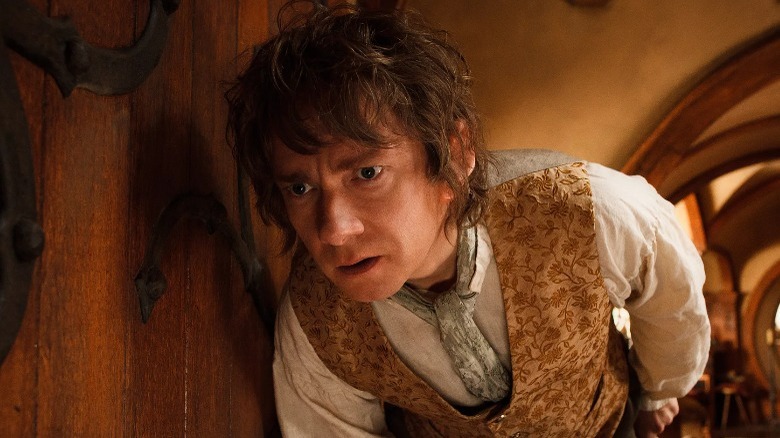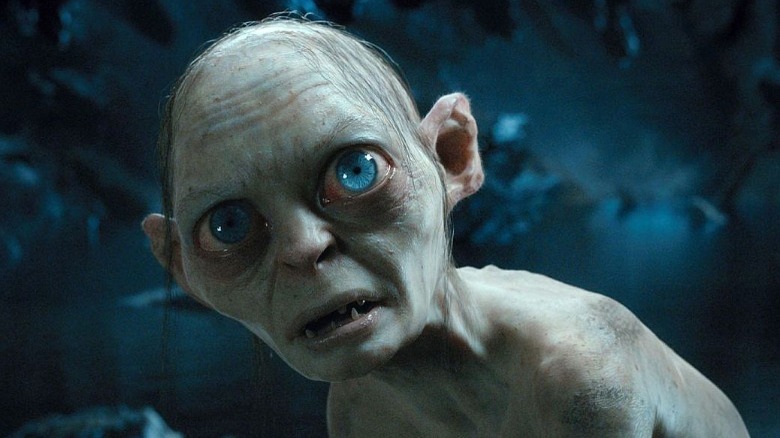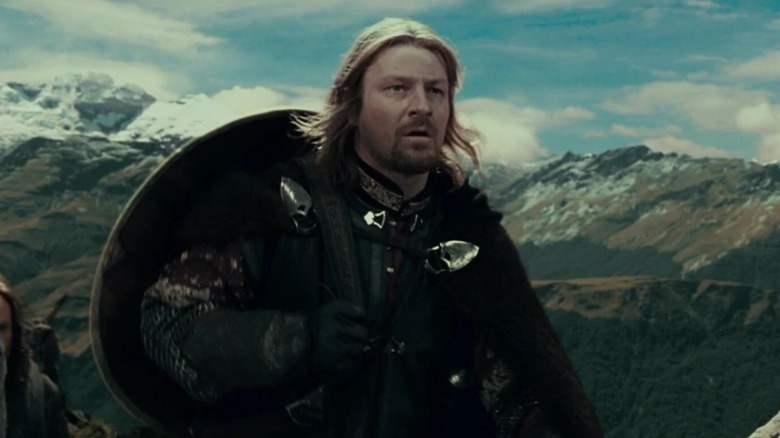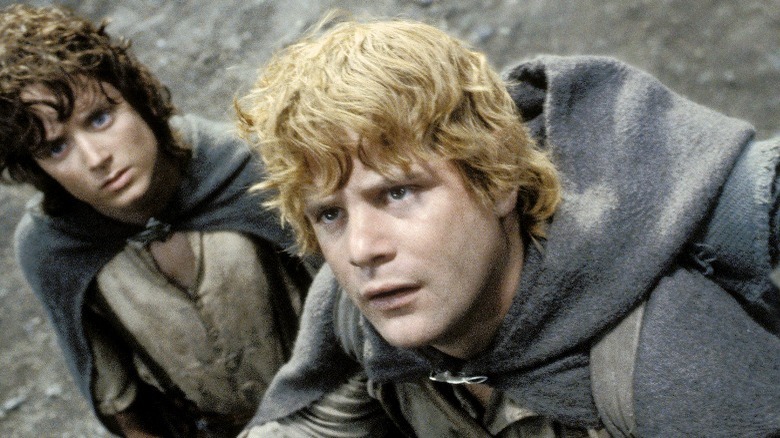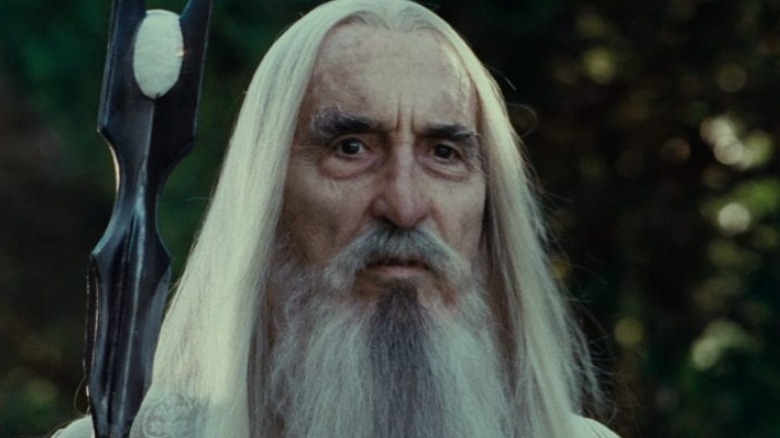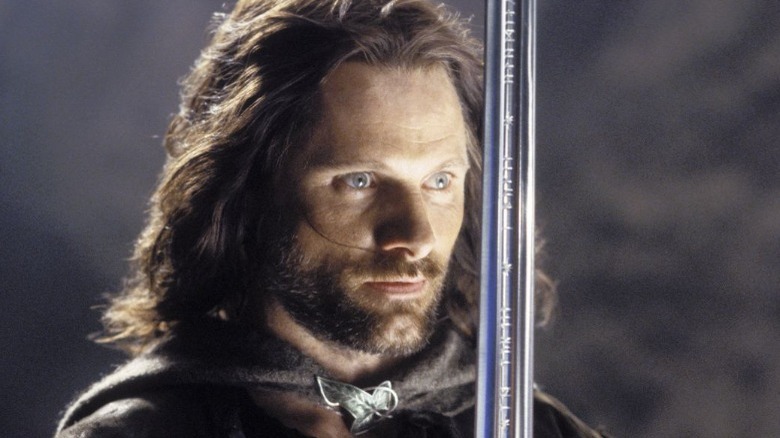Unexpected Demands Made By Lord Of The Rings Actors
There's little doubt that Peter Jackson's "The Lord of the Rings" trilogy is one of the most important film series of the 21st century. It helped revitalize the fantasy genre, brought the novels back into popular culture, and made nerd culture overall seem cool. The fact that it grossed billions of dollars and won a whole host of awards helped cement its place in cinematic history as well. All that success led to new video games, a prequel film trilogy in the form of "The Hobbit," and a big-budget television series in Amazon's "The Lord of the Rings: The Rings of Power."
"The Lord of the Rings" also launched the careers of several stars, such as Orlando Bloom, and made household names of a number of already established actors. Although you might think that any performer would jump at the chance to appear in such a high-profile franchise, the actors weren't necessarily willing to just turn up and get on with their work. In fact, a few of them had some pretty unusual or even outlandish demands in order to appear in the films.
While none of the cast could be said to be divas, some actors did have peculiar requests and conditions that made life a bit more complicated for the filmmakers. Even the biggest fans may not know about these unexpected actor demands for "The Lord of the Rings."
Christopher Lee really wanted to play Gandalf
Christopher Lee is the man responsible for bringing the wizard Saruman — leader of the White Council — to life in Peter Jackson's "The Lord of the Rings." Meant to oppose Sauron's power, he ultimately seeks that strength for himself and becomes a primary antagonist in both "The Fellowship of the Ring" and "The Two Towers" before his death in the final film. The actor was praised for his performance, with The Guardian calling it "powerfully resonant" and one of the highlights of the trilogy.
Yet, Lee wasn't initially interested in playing Saruman. Instead, he wanted to play an entirely different wizard — Gandalf the Grey. Speaking in an interview with Entertainment Weekly following Lee's death, Peter Jackson revealed that the actor was interested entirely in auditioning for Gandalf. In fact, when Lee heard that Jackson was making the trilogy, he reached out to the filmmakers directly. During a meeting between Lee, Jackson, and Fran Walsh, Lee outlined why he would be the perfect choice for Gandalf, despite the fact that the pair were already in discussions with Ian McKellen to play the heroic wizard.
The director explained that Lee effectively forced them to record him doing some lines as Gandalf before leaving, despite the fact that Jackson and Walsh were prepared to offer him the role of Saruman there and then. He was offered the part a few weeks later after McKellen had been confirmed as Gandalf.
John Rhys-Davies could barely wear his costume
It wasn't unusual for actors in "The Lord of the Rings" to arrive incredibly early on set to provide plenty of time for makeup and prosthetics. Stephen Ure, who played an orc, told NME that it could take up to four and a half hours to get ready for shooting, meaning he would have to be on set by 2:00 a.m. This kind of regular process would take a toll on anyone, but it was extra hard for John Rhys-Davies.
The actor, who plays the dwarf Gimli and provides the voice for Treebeard, had a severe allergic reaction to the facial prosthetics used to transform him. The pain and discomfort this caused Rhys-Davies eventually meant that he had to spend as much time as possible out of makeup. Per IndieWire, stunt double Brett Beattie ended up being used for more shots as a result, with the original actor mainly used for close-ups. Beattie played a major role, interacting with the main cast and even getting the Elvish word for nine tattooed on his body with the rest of the actors who were part of the fellowship (per Polygon).
Meanwhile, the facial prosthetics were such a problem for Rhys-Davies that he refused to appear in the "Hobbit" films. "I have already completely ruled it out," the actor said to Empire in 2009. "There's a sentimental part of me that would love to be involved again. Really I am not sure my face can take that sort of punishment any more [sic]."
Many in the cast requested better bonuses
When the cast was announced for "The Lord of the Rings," there were plenty of unknown faces that fans had to get used to quickly. Many of the actors were relative newcomers to Hollywood, with only a few appearances to their names when they were chosen to portray the various inhabitants of Middle-earth. For example, Elijah Wood was just 19 when he appeared in "The Fellowship of the Ring," and though he was a known quantity in the industry before that, the likes of Billy Boyd, Dominic Monaghan, and Orlando Bloom really got their breakthroughs in Jackson's trilogy.
That might be why so many of the actors involved in the series wrote to Time Warner chairman Richard Parsons in 2003 to ask for higher bonuses following the success of the movies. According to The Guardian, the letter was signed by 18 members of the cast who requested better compensation for their roles. As little-known actors when they were cast, their pay would likely have been far lower than established stars. It's completely understandable why they'd ask for more money considering the huge financial success of the trilogy.
Viggo Mortensen wanted to ride a stallion
Viggo Mortensen plays Aragorn spectacularly in "The Lord of the Rings," and he apparently wanted to have a strong level of input on the way the character was brought to life in the films. A big example of this is the fact that he only wanted to ride stallions during filming, rather than geldings. The difference between the two is that a gelding is a castrated male horse, while a stallion is one that hasn't been neutered and is still capable of siring offspring.
This rather specific demand came to light during a 2006 Q&A with Miranda Otto, the actor who portrays Éowyn in the trilogy. She explained that the gelding she rode in the films was originally bought for Mortensen, but that he wanted to ride a stallion, so it was instead given to her. Mortensen actually rode two different horses during his time shooting the films and ultimately purchased them both once the shoot was completed. He told NME that he also went on to buy the white horse that Arwen rode in "The Fellowship of the Ring" as a gift for the stuntwoman involved in the scene.
The actor seems to have had a close relationship with the horses he worked with in the trilogy. "I just feel calm when I'm around them, just interacting with them," he explained in an interview with Brego.net.
Ian McKellen wanted less green screen acting
The "Lord of the Rings" trilogy required a lot of special effects and camera trickery, and not just for the massive battle scenes or to portray magical creatures. Just getting the various members of the fellowship to look the right size next to each other was a difficult task. Speaking to Wired, Elijah Wood explained that scenes would be shot without certain actors and that their characters would be put back in later using blue screen effects. Additionally, forced perspective was used to make the hobbits appear small next to the likes of Gandalf and Aragorn, in addition to using stand-in doubles.
While these methods had the desired effect on screen for viewers, they weren't always fun for the actors. While it wasn't as much of an issue in "The Lord of the Rings," when it came to filming "The Hobbit," Ian McKellen found that Peter Jackson had become more reliant on technology. This meant the actor was forced to work in isolation in front of green screens rather than with his fellow performers — something that caused him a lot of distress and even prompted him to consider quitting acting.
Fortunately for audiences and McKellen, the director was able to find workarounds that involved less technology-focused techniques, like those used in the previous movies, to make the process more enjoyable and natural (per Yahoo).
Martin Freeman shifted the entire production of The Hobbit
Martin Freeman was cast as a younger version of Bilbo Baggins in "The Hobbit" films, taking over from Ian Holm who had portrayed the character in "The Lord of the Rings." By that time, he was already an established star in the UK and abroad and had appeared in many films and television series. These included "The Office," "Love Actually," "Shaun of the Dead," and "The Hitchhiker's Guide to the Galaxy."
When it came time to film the first part of the trilogy, Freeman was busy working on "Sherlock," prompting the production team to make some changes to keep the actor happy and ensure he would stay on as the protagonist. Speaking to Vanity Fair, Freeman revealed that although he desperately wanted to play Bilbo and Peter Jackson was dead set on him, his schedule with the BBC meant it would be almost impossible.
According to Freeman, Jackson effectively rearranged the entire production schedule for "The Hobbit," giving the actor the opportunity to come to New Zealand and film earlier before returning to the UK for "Sherlock." Once the television show was wrapped up, he could return to finish his work on the "Lord of the Rings" prequel. Speaking with Vanity Fair, Freeman said that Jackson's support was "an amazing thing to hear" and called it a huge vote of confidence.
Andy Serkis didn't just want to provide a voice
When viewers get their first small glimpse of Gollum in "The Fellowship of the Ring," the character looks very different from what would appear in the two sequels. That's because this first model is what Gollum was originally intended to be — an entirely CGI creation with Andy Serkis simply providing the voice of the character.
Things ended up a little differently. Gollum became a more fully realized character through Serkis' performance capture work. One reason for this was that Jackson and the other filmmakers were unhappy with how Gollum looked at first (per Vulture). The other reason was simply Serkis himself, who was originally commissioned simply to provide the character's voice. "I don't want to play a voice," Serkis told his agent at the time, but he agreed to the part anyway (per Wired). During his audition, he acted out the character's physicality, which apparently was so compelling that it convinced Peter Jackson to bring him on set.
At the time, motion capture was still in its infancy. Serkis wore a suit to track the movements of his limbs and body, but facial expressions for Gollum were animated manually. As Jackson saw more of Serkis' performance, he pushed to have Gollum more closely resemble the actor. "At some point, Jackson told us that we had to redesign Gollum's facial structure to resemble Andy's," Weta Digital director Joe Letteri told Wired. The change was almost certainly for the best, with Gollum being praised by critics and helping to set a new standard for motion capture in movies.
Sean Bean wouldn't fly to locations
As you might expect for a movie series that involves characters visiting snowy mountains, forests, desolate swamps, and massive fields, there were some pretty remote filming locations used to shoot the "Lord of the Rings" trilogy. With filming taking place entirely in New Zealand, the cast and crew utilized more than 150 locations across the North and South Islands of the country. This meant that it was sometimes necessary for them to use more novel methods of travel, including helicopter rides to the tops of mountains.
This posed a problem for one member of the "Fellowship of the Ring" cast in particular. Sean Bean, who plays Boromir in the movies, had a fear of flying. "I don't like flying. I'm okay now that I've gotten used to it, but at that time, I was a little bit scared," Bean said in an interview with Jonathan Ross. "Whenever I could use any other means to get to the location, I would."
Those other means of getting to shoots usually meant that Bean would have to hike several miles to get to the location. The actor even uses a ski-lift when it was available to get partway up the mountain but was then forced to walk the rest of the way in his full Boromir costume. "Every day, as we all flew over, we would look down and there'd be this tiny black speck climbing the cliff," Peter Jackson said in a behind-the-scenes DVD feature.
Sean Astin requested to play Aragorn
Unlike some of the other hobbits who were cast in "The Lord of the Rings," Sean Astin was already well known in the movie industry at the time. He'd risen to fame playing Mikey Walsh in "The Goonies" as a child and had a number of film and television roles before landing the part of Samwise Gamgee in the trilogy. But despite the fact that Sam is a hugely important figure in the story and someone who has a large amount of screen time, Astin had aspirations to play another character from the books.
In a special reunion video hosted by self-obsessed "The Lord of the Rings" fan Stephen Colbert, Astin spoke about his audition for the trilogy. The actor seemed to feel that while he had been selected to play Sam, he was able to play other parts and expressed an interest in Aragorn. During the audition process he thought, "Are you pigeon-holing me? Is this typecasting?" and asked if he could play Aragorn in the movie. A quick reply from his agent and the filmmakers put a quick stop to this thought before it could develop any further. That's probably for the best, as the films just wouldn't be the same without Astin's excellent performance as Sam.
Christopher Lee had constant Saruman commentary
Christopher Lee was no ordinary actor on the set of "The Lord of the Rings." He had a long history with the books and was such a huge fan that he apparently re-read them every year (per The Independent). This made him a knowledgeable person when it came to the source text, with Peter Jackson telling Entertainment Weekly that he "could freely quote vast chunks" from the novels.
Such was his passion for "The Lord of the Rings" that Lee would constantly talk to the director about his character and make suggestions for rewrites. He once told Jackson while discussing a scene involving Saruman, "You must understand, Peter — he's really not an evil man" (per Entertainment Weekly). He was also incredibly upset over the fact that his scenes in the third film were cut in the theatrical release. The Guardian reported that Lee was so angered by the changes that he refused to attend the London premiere of the movie.
Another, slightly more sinister moment came during the shooting of "The Return of the King." While filming the scene where Wormtongue kills Saruman, Lee described to the director the sound a man actually makes when being stabbed in the back. According to The Spectator, Lee worked as an intelligence officer for the RAF earlier in his life and was attached to special forces units such as the SAS during the Second World War. Jackson, accordingly, took the actor at his word.
Viggo Mortensen asked for many rewrites to the script
Viggo Mortensen isn't someone who takes his acting roles lightly, and he put a large amount of effort into preparing for the role of Aragorn after he was cast in "The Lord of the Rings." In fact, according to Sean Astin's autobiography "There and Back Again – An Actor's Tale," Mortensen was so serious about the role that he even brought his sword in public with him in order to stay in character (via The Sydney Morning Herald). Once he knew he would play the character in the film series, he read the books and became a student of the text.
What this meant for the filmmakers and the cast was that Mortensen was constantly questioning the motivation of his character and trying to understand everything he did. Astin explained in his book that Mortensen would regularly offer suggestions and changes that led to rewrites as he attempted to improve the character and make him more authentic to the source material. Writing in his autobiography, Astin said, "He would come to [the filmmakers] every day, it seemed, with thoughts and ideas and suggestions, things the script apparently missed about his character."
This might have made Mortensen a bit unpopular at times, as the cast was already having to deal with a script that was frequently changing and evolving. Responding to a question from Elijah Wood in an interview with Empire, Ian McKellen complained that the script rewrites were "tiresome," but that they kept the actors "on our toes."
